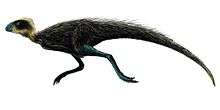Gojirasaurus
| Gojirasaurus Temporal range: Late Triassic, 210 Ma | |
|---|---|
 | |
| Hypothetical restoration | |
| Scientific classification | |
| Kingdom: | Animalia |
| Phylum: | Chordata |
| Class: | Reptilia |
| Clade: | Dinosauria |
| Order: | Saurischia |
| Suborder: | Theropoda |
| Superfamily: | †Coelophysoidea |
| Genus: | †Gojirasaurus Carpenter, 1997 |
| Type species | |
| †Gojirasaurus quayi Carpenter, 1997 | |
Gojirasaurus (meaning "Godzilla Lizard")[1] is a possibly dubious genus of dinosaur named after the giant monster movie character Gojira (the Japanese name for Godzilla).
Etymology
The composite term Gojirasaurus is derived from the name of the giant Japanese movie monster "Gojira" (Godzilla) and the Greek word "sauros" (σαυρος) meaning "lizard";[2] thus, "Godzilla lizard". In addition, a theropod dinosaur with the name Godzillasaurus exists in the Heisei era of Godzilla films. "Gojira" was selected as a reference to the great size of this theropod, which exceeded that of its Triassic counterparts. The specific name "quayi", is a reference to Quay County, New Mexico, where the holotype specimen was discovered. Gojirasaurus was described and named by Kenneth Carpenter in 1997 and the type species is Gojirasaurus quayi.
Description
Gojirasaurus is one of the largest meat-eating dinosaurs known from the Triassic Period, almost the size of its relative, the large coelophysoid Dilophosaurus.[3][4] The size of its tibia was 469 mm, which was comparable to that of Liliensternus (409 mm) and Dilophosaurus (555 mm), suggesting that it was a large triassic dinosaur, estimated to be about 5.5 m (18 ft) long, which can be extrapolated to a weight of approximately 150–200 kg (330–440 lb).[5] Carpenter (1997) pointed to features of the pelvis and ankle suggesting that this was an immature individual, and could therefore have grown to even a larger size in maturity[1] Specimen NMMNH P-4666 which consists of only a pubis, was referred to this genus by Hunt in 1994.
Classification
In 1994 Hunt, in his unpublished thesis, described and named this material "Revueltoraptor lucasi" which is now considered a nomen nudum.[6] Carpenter officially described and named UCM 47221, Gojirasaurus quayi in 1997 and classified it as a coelophysoid. The original remains attributed to this dinosaur included a serrated tooth, a cervical rib, two anterior dorsal ribs, one posterior dorsal rib, a right scapula, two gastralia, four vertebrae, one anterior chevron, a right pubis, a left tibia, and one metatarsal.[1] Tykoski and Rowe (2004) and later Carrano et al. (2005) agreed that Gojirasaurus is more derived than Dilophosaurus[7][8] However, later study by Nesbitt et al. (2007) showed that the vertebrae actually belonged to the rauisuchian Shuvosaurus, and the pubis and tibia belonged to another coelophysoid, indistinguishable from the contemporary Coelophysis, making the status of Gojirasaurus as a valid genus dubious.[6]
Distinguishing anatomical features
A diagnosis is a statement of the anatomical features of an organism (or group) that collectively distinguish it from all other organisms. Some, but not all, of the features in a diagnosis are also autapomorphies. An autapomorphy is a distinctive anatomical feature that is unique to a given organism or group.
According to Nesbitt et al. (2007), Gojirasaurus can be distinguished based on the fact that its tibia is more robust than that of its relative Coelophysis.[1] Mortimer (2012) has proposed that the observed difference in the leg bone might be just size-related, and not a true apomorphy. Rauhut (2003) attempted to diagnose this genus based on the fact that the mid/posterior dorsal vertebrae had taller neural spines than those observed in other coelophysoids. However, the reassignment of the dorsal vertebrae on which the diagnosis was based would render it invalid.[9]
Paleoecology
The only known specimen of Gojirasaurus was discovered in the Cooper Canyon Formation of the Dockum Group near Revuelto Creek, Quay County, in New Mexico. This genus was discovered in 1981, in gray carbonaceous mudstone deposited during the Norian stage of the Late Triassic, which based on magnetostratigraphy,[10] was approximately 228 to 208 million years ago. This specimen is housed in the collection of the University of Colorado Museum, in Boulder, Colorado. Gojirasaurus's assignment to the Coelophysoidea, would suggest that it was a bipedal, terrestrial, actively mobile carnivore. Contemporaries of Gojirasaurus included the pseudosuchian Shuvosaurus, and the phytosaur Rutiodon.
See also
References
- 1 2 3 4 K. Carpenter, 1997, "A giant coelophysoid (Ceratosauria) theropod from the Upper Triassic of New Mexico, USA", Neues Jahrbuch für Geologie und Paläontologie, Abhandlungen 205(2): 189-208
- ↑ Liddell, Henry George and Robert Scott (1980). A Greek-English Lexicon (Abridged Edition). United Kingdom: Oxford University Press. ISBN 0-19-910207-4.
- ↑ Parrish, J. M., and Carpenter, K., 1986, A new vertebrate fauna from the Dockum Formation (Late Triassic) of eastern New Mexico: In: The Beginning of the Age of Dinosaurs, Faunal change across the Triassic Jurassic Boundary, edited by Padian, K., Cambridge University Press, p. 151-160.
- ↑ Strauss, Bob. "Gojirasaurus". About.com:Dinosaurs. New York Times. Retrieved 17 January 2010.
- ↑ "Gojirasaurus". Archived from the original on 14 November 2007. Retrieved 7 December 2012.
- 1 2 Nesbitt, Irmis and Parker (2007). "A critical re-evaluation of the Late Triassic dinosaur taxa of North America." Journal of Systematic Palaeontology, 5(2): 209–243.
- ↑ Tykoski, R.S. & Rowe, T. (2004). "Ceratosauria". In: Weishampel, D.B., Dodson, P., & Osmolska, H. (Eds.) The Dinosauria (2nd edition). Berkeley: University of California Press. Pp. 47–70 ISBN 0-520-24209-2
- ↑ Carrano, Hutchinson and Sampson, 2005. New information on Segisaurus halli, a small theropod dinosaur from the Early Jurassic of Arizona. Journal of Vertebrate Paleontology. 25(4), 835–849.
- ↑ Mortimer, Mickey (2012). "Coelophysoidea".
- ↑ Molina-Garza, R. S., Geissman, J. W., and Lucas, S. G. 1993. Late Carnian-early Norian magnetostratigraphy from nonmarine strata, Chinle Group, New Mexico.



